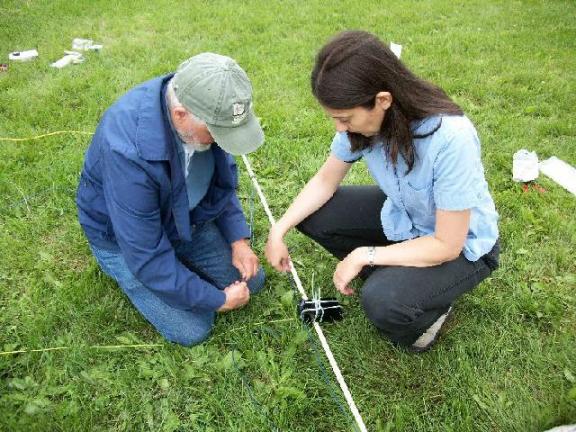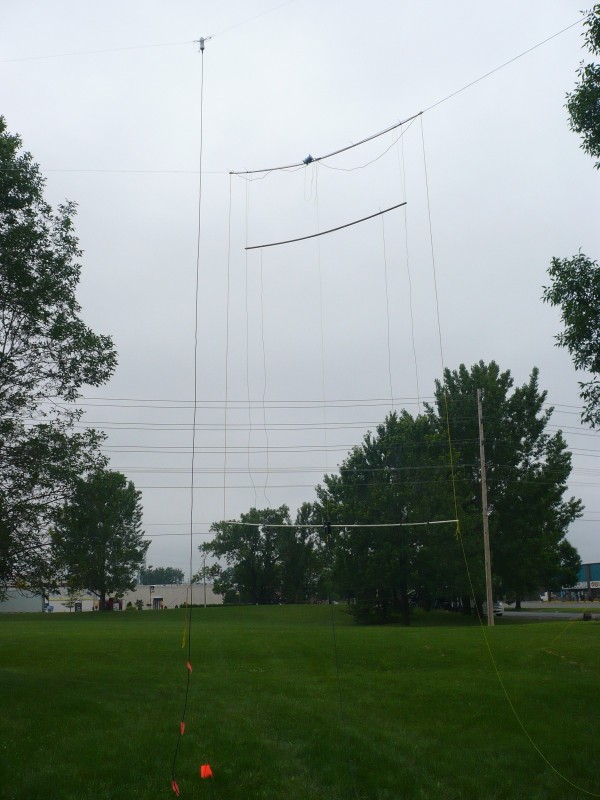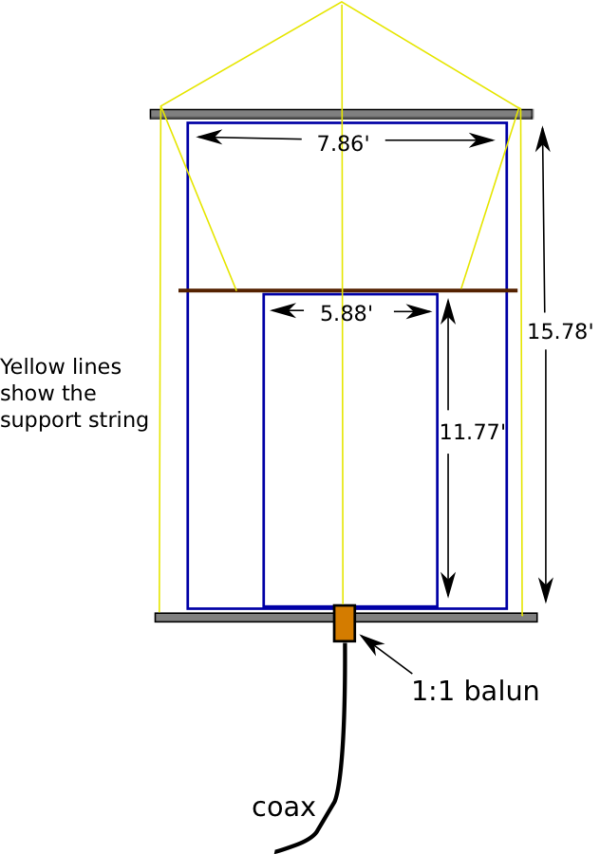Maplecon 2010 Report
I attended the first Maplecon last weekend, which was a gathering of Canadian QRPers. The venue was Emily Provincial Park campground. Gerry, VA3GLT, and myself headed down on Saturday morning, despite the convention’s start on the Friday, as both of us had commitments in the afternoon and evening of Friday 20th Aug. We had an early start and drove down the 401 highway to Port Hope then turned off and travelled North to the park. By noon we arrived and had put up the tent and an antenna.
The antenna for this event was a freshly homebrewed doublet made from some TV twin-feed I bought a few years ago and now decided to use. It was split 16′ 7″ down to form two arms of the doublet, and the remaining 23′ or so of twin feed was the feedline. At the end of the twin feed we installed a homebrew 4:1 current balun, which I had built a few years ago. The antenna was raised between two trees high enough that the feedline dropped vertically down and just reached into the tent. A short run of coax was used from the balun to my Elecraft K2. It tuned on 40m, 20m, 17m, 15m and surprisingly 80m (given the length of the antenna is would be a pretty inefficient). I could not get a tune on 10m. Possibly if I took out the 4:1 balun I may have made it.
There was a just short of thirty attendees at the convention and we chatted with quite a few. There were three tables set out as stalls, one with QRP rigs, one with QRP-ARCI information and one with Youkits radios. I would have like to have spent more time looking at the QRP equipment table, but things felt a little rushed as we had arrived late. We had a lovely barbecue lunch prepared by Jeff, VE3JFF, and his family after which I had a chat with Yimin and Fred, VE3FAL from Youkits about their new line of QRP radios. That will be covered in a future post as I made a recording of that conversation.
There was an antenna competition on so I spent a little time in the tent in the afternoon trying to make contacts on PSK31. Beside the antenna and the K2 I was using a little Asus notebook, a homebrew interface for digimodes and a large battery pack. It is so large that Martin, VA3SIE accused me of being a secret QRO operator! (That hurt Martin).
I had little success with contacting stations on 20m PSK until finally just before dinner when we made a contact with a weak station that was calling CQ. I replied and was acknowledged by Mirek, SP9ONC in Kozy, Poland. He was running QRP from a TS-2000 and and we exchanged details. I was really pleased that my first contact was DX and a QRP-QRP contact too. Soon after came my second contact Fred, KD8AQ in Mt Pleasant, TX and we had a nice chat. As the call for the chilli dinner had gone up earlier I had to break off that conversation.
Dinner was provided by the Ottawa Valley QRP Club and that was the second good meal. The chilli was tasty and Martin, VA3SIE, had brought some British delicacies for dessert, including Battenberg cake, which I had not eaten in many years as it does not often appear on shelves in Canadian stores.
After dinner there was the antenna competition, door prizes and a raffle for a ‘shack in a box’. For the antenna competition Michael, VE3WMB, won the prize for the best technical design with a folded over vertical antenna, and I won for the best performing antenna with the DX contact with SP9ONC. I was extremely pleased to find my prize was a Norcal BLT tuner which will very likely become the tuner for that doublet in future.
There were plenty of door prizes including several transceivers. Gerry, VA3GLT, was lucky to get the first of two HB1A transceivers that had been generously donated by Youkits. There were so many door prizes that I think all attendees went away with something. I won a set of pliers and a year’s subscription to QRP Quarterly, the QRP ARCI’s excellent magazine. So when my current subscription is up I can use that.
After all the prizes had been given out there was chatting into the evening and then Gerry, Martin and myself went back to the tent and made two more contacts on 20m. These were Tom, KJ4QDZ , in Lillian, AL and Virgil, WA5TLP, in Willston, ND. Not too many contacts but enough to make me happy with the performance of the antenna.
Over Saturday night and Sunday morning there was a lot of rain. So after breakfast next morning there were a lot of people leaving. Gerry and I thought it was prudent to take the tent down during a brief lull in the rain so there was no making contacts, just collapsing and packing a wet tent. We thanked Jeff, VE3JFF, for all his hard work that had resulted in a successful first Maplecon 2010, said goodbye to those that remained and we headed home before noon on Sunday.
Will there be another Maplecon next year? Well after the prize giving it was discussed by all and it was unanimous to have another. So here is looking forward to Maplecon 2011.
First contacts with the Warbler
Despite Summer not being the best time of year for 80m QSOs I have made a couple of contacts over the last two nights with the recently completed Warbler.
The first was a PSK31 contact with AE1Q who was about 285 miles away in Belgrade Lakes, Maine. The next was an Olivia 8/500 contact with VE3FMC in St Thomas, Ontario, about 325 miles away. Both QSOs proved to be tougher copy for the other stations as the Warbler puts out only about 2 Watts. However, they were successful QSOs and as can be seen by the picture above the Warbler receives well.
AE1Q gave me an IMD report which was -24 dB which is reasonable given the simplicity of the rig, but I would like it to be below -30dB.
I was fortunate and pleased that the second contact was using Olivia. This is a nice mode for QRP. For those wanting to try Olivia I recommend you read the information on the Olivia website by Gary, WB8ROL, including his QST article. Gary writes great articles (including one in the recent amateur radio edition of Linux Journal) and I have enjoyed a few Olivia QSOs with him.
Finally, if you do want to try Olivia or any multifrequency keying mode with the Warbler, you must remember that you are operating on LSB with the Warbler. Most digimode operators will be using USB so the frequencies will be reversed. The digimode software, Fldigi, offers a simple solution to this, you must select the “Rv” or ‘reverse’ button (see the lower right of the Fldigi window above, which is selected and green). You do not need to worry about this button if you just use PSK31 as it is symmetrical about a centre frequency.
Transformation of Radio Amateurs of Canada

Radio Amateurs of Canada is the national amateur radio organization here in Canada. It has just had its annual general meeting and coming out from this is a call for transformation. Peter of the RAC blog has sent me a link to the important news and I thought I would pass it on, as I know I have a few Canadian readers of my blog.
I am not going to comment here on what I have read, but will think about it and probably send my thoughts and ideas to RAC. Take a look at the proposal and if you want, send your thoughts to either RAC or post them here, it would be good to have an open discussion. If you are not a Canadian please still take a look at the details, as other national organizations may be heading in a similar direction, or have faced similar issues.
If you have thoughts and opinions on what you want from a national amateur radio organization please make a comment.
Dual band rectangular loop antenna for 15m and 10m
This is the second article describing the two antennas that were used by the Carleton University Amateur Radio Club (CUARC) at Field Day 2010. The first post described an off-centre fed dipole with a 200 ohm feedpoint impedance. This post describes the second antenna a loop antenna that worked on two bands, 15m and 10m.
I like loop antennas. I have built large loops for amateur bands, as well as small loops for receiving (which are quite different to their bigger cousins) and have found both types perform well. They are less sensitive to local noise, so often giving good signal to noise ratios. As CUARC was to operate on 10m and 15m at the Field Day site I was considering a loop for one of these bands, however, which one? 10m could be fun if there was an opening, plus the antenna would be smaller than 15m. However, 15m would be more likely to be open. In searching the internet I came across a potential solution as KT4QW’s website who describes a 17m and 10m hanging loop antenna. The idea was simple and elegant, two vertical and rectangular loops fed from the same point, similar as to how multi-band dipoles can be fed from the same feedpoint (sometimes called a fan dipole).
I went about calculating the basic design. A full-wave loop’s total perimeter length is calculated by:
Length (in feet) = 1005 / f,
where f is the intended frequency of operation in MHz.
So for 21.3 MHz that would be a total loop length of 47.2ft and for 28.5MHz it would be 35.3ft.
To attain a 50Ω feedpoint the loop needs to be rectangular, with the longer length vertical. Studying J. Carr’s Loop Antenna Handbook and KT4QW’s dimensions the sides were close to being 1/3 of the total loop length for a vertical side and 1/6 for the horizontal side. So this then gave a design as shown below.
To support the wire I bought two 10ft lengths of PVC piping. The inner support for the upper part of the 10m antenna was some thin wood. Both the wood and PVC were drilled with holes prior to Field Day. The wire was cut from a single 100ft roll and the whole antenna was built by CUARC members at the Field Day site on the day. At the feed point a 1:1 balun was used, an Elecraft BL2. The intention was to suspend the antenna from a single central point so the loop(s) could be rotated, using a line tied to one lower corner. However, we could not get enough height and clearance from tree branches, so we mounted it between two trees and it keep it static with the signal projecting in South-West and North-East directions.

Loop being assembled by Gerry, VA3GLT, (left) and Maria, VA3MMI, (right). (Photograph courtesy and copyright of Chris Wiesner, VA3SM).
After construction the SWR was measured and found to be nicely below 2:1 for both bands (at least the lower part of 10m which is quite a wide band). As mentioned in the earlier post Maria, VA3MMI, brought a portable analyzer to the site on Sunday morning and the trace of the SWR profile is shown below. You can see the antenna has two nice dips in the SWR within the two bands. In an effort to see the usable bandwidth (below 2:1 SWR) the max SWR on the Y axis has be limited to 2.0:1.
To further examine the bandwidth of the two dips in SWR Maria, VA3MMI, set markers at the 2:1 points of the SWR curves. These are shown in the next two traces (one for each band). Both show good usable portions of the bands for phone, see the tables on the right of the trace. (Thanks to VA3MMI for the measurements and traces).
So, with the off-centre fed dipole and this dual loop antenna, CUARC constructed two antennas for Field Day that worked on 15m and 10m without the need of an antenna tuner unit. Performance was good on both antennas and I heard at least one comment that that we had a strong signal (we used 100W). During Field Day we made over 100 contacts on 15m and 16 contacts on 10m. Not bad, as for many of the CUARC members this was their first chance at operating on HF. It was enjoyable for the newly licensed CUARC members to build and then use the two antennas and to find both worked successfully. For me that was perhaps the highlight of 2010 Field Day.
Warbler now finished and working
I finally finished my Small Wonder Labs Warbler kit last night. This was started probably two years ago and then was shelved for no particular reason other than I was working on other projects. Last week I decided it was time to get it finished and so have been working on it in the evenings. It is a nice kit with a clever design based around colour burst crystals and the receiver is direct conversion. It was straight forward to build but note there are two SOIC components, the SA612 mixers (look for U1 and U2 in the photo above).
When it came to the smoke test it worked first time. I adjusted the one tuning capacitor (the only adjustment), for frequency alignment and checked power out. Alignment was done as recommended with W1AW which was coming in well (see the screenshot below). On transmit, I get 2W out on my Radio Shack power meter. It is expected that you can get 3 to 4W out of the Warbler. Given the accuracy of the meter I happy with what I measured.
I have an aluminium enclosure, which is a tight fit for the board, so there is some careful drilling and filing to come. You can see in the photograph I have already cut out the corners to accommodate for the enclosure screw mounts.
Given the simplicity of the transceiver I am very pleased at how well it works. No contacts yet, so will have to see what the IMD is later. Anyone within 100 miles or so of Ottawa want to try a QSO?
Try some Cornbread Road
Jeff, KE9V, has recently released a podcast called Cornbread Road. It is quite a different type of amateur radio podcast. It is not a commentary or discussion of amateur radio, it is a story with amateur radio involved in it. The production quality is high and I have found the story captivating. Jeff tells me the next episode, number 6, is out tomorrow (Sunday 1st Aug.). If you have not already sampled Cornbread Road give it a try, I recommend it.














 Subscribe
Subscribe